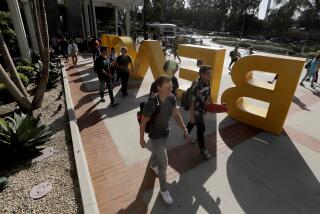Distribution of School Budget Cuts Questioned : Education: Teacher union leader wonders whether administration has taken fair share of reductions. Administrators reply that essential services cannot be pared.
- Share via
On hundreds of campuses across the Los Angeles Unified School District, it is hard to escape the reality that school budgets have been slashed to the bone.
Principals can no longer afford to hire enough substitute teachers, teachers run low on supplies, classrooms are filled to overflowing, and “extras” such as field trips have virtually disappeared.
But downtown, at the district’s administrative headquarters, the results of three years of gut-wrenching budget cuts are more elusive.
Administrative spending was reduced by more than 17% this year, but the savings have come largely through the consolidation of two departments responsible for the repair and upkeep of schools, cuts in the staff overseeing the district’s stalled school construction program, the demotion of some instructional advisers, and cuts in the personnel and transportation divisions.
Untouched were such luxury items as the chauffeur-driven cars available for school board members and the six-figure salaries for district administrators--expenditures that draw the ire of students and teachers wilting in classrooms without air-conditioning and of parents asked to ante up money to hire music teachers the district can’t afford.
They argue that the school board should have eliminated such administrative costs when they reduced the district’s 1991-92 budget by $275 million because of cuts in state spending.
“When you look at the kinds of services we’ve lost at the schools . . . and you compare that to the level of cuts made at the administrative level, you have to wonder what the priorities of this district are,” said teachers union President Helen Bernstein.
Earlier this year, union officials joined with district leaders in a rare display of unanimity to battle against state funding cuts. But that delicate truce is now threatened by the dispute over whether the administration has taken its fair share of the cuts.
The district needs its unions to agree to more than $100 million in pay and benefit cuts that have already been written into this year’s budget. But Bernstein said her members will not accept pay cuts unless more is whittled from administrative costs--a threat that could pave the way for a teachers strike and lead to even deeper cuts in school spending.
In actual dollars, less money can be realized through administrative cuts because those costs represent only about 7% of the district’s total $2.8-billion general fund budget. When the board cut administrative spending by more than 17%, that yielded about $35 million. A 10% cutback in school spending generated almost four times that amount--saving $132 million.
Still, teachers--and increasingly parents and politicians--argue that even the smallest savings in administrative spending are worth pursuing when classrooms are feeling such tough budgetary pressure.
District Supt. Bill Anton acknowledges that the cuts hit schools the hardest this year. Almost half of the $275-million cut came from school spending. About 13% were administrative reductions, and the remaining 38% is to be made up through employee pay and benefit cuts.
Unlike in previous years, the school cuts struck to the heart of the instructional program--resulting in the layoff of almost 2,000 teachers, boosting class sizes to the largest in the nation and paring course offerings to bare minimums.
But Anton maintains that the bureaucracy cannot sustain those kind of cuts. Essential, but expensive, services such as payroll processing and financial planning “you just can’t cut and still have an efficient operation that can get the job done,” he contends.
In deciding what to cut, the school board left in place several programs critics say are hardly essential.
Spared were such things as the district’s television station, the school board’s advisory commissions and the cars provided to high-ranking administrators. The board made no cuts in its 17-member staff and left intact the $4,000 annual travel allowance each board member receives.
In addition, this year’s administrative budget includes such items as $72,000 to be spent on advertising campaigns to recruit new employees--in a district that has laid off more than 2,000 people this year.
More than $75,000 is set aside to pay dues to professional organizations, and $611,000 is allotted for travel and conferences, all for administrators.
“We’ve accepted the fact that the district is terribly under-funded, but when you’re in financial crisis, you give up the luxuries first, before you go to the classrooms and take away the things that make a difference to teachers and kids,” Bernstein argued.
The union suggested several ways to save money--such as consolidating the three separate offices that handle the district’s legal affairs, shutting down much of the $17-million high-tech computer division, selling the district’s television station and scaling back special programs such as adult education that siphon off money from the district’s general fund.
But Anton contends that the cuts suggested by union leaders would have only symbolic value, that they would be impractical and that most would do little to close the giant hole in the district’s finances.
Even a big-ticket item, such as the closing district-owned station that televises educational programs and school board meetings, would generate less than $2 million in savings--or about $3 per student.
In comparison, the increase in class size saved the district more than $55 million. Another $20 million was saved by cutting by almost half the fund used to pay substitute teachers.
Many proposed--but rejected--administrative cuts drew support from some board members, but failed to garner the necessary four-vote majority. And when deliberations ended in June, the board remained $10 million short of its goal, and evenly split on whether to close that gap with additional administrative reductions or employee pay cuts.
Board President Warren Furutani says he now believes board support is growing for deeper administrative reductions--in part because it has been difficult selling the notion of pay cuts to overworked teachers who believe the bureaucracy is bloated by high-paid administrators.
“I think we’ve got a lean operation, but I also think there’s more we can cut and that more will be cut before we’re finished,” Furutani said.
More than 30 district officials are paid annual salaries above $100,000, including the 25 assistant superintendents, two legal advisers, the district’s chief lobbyist, six of its top financial and business managers and the director of classified personnel. Teachers average about $45,000 a year.
The high administrative salaries have repeatedly come under fire from teachers, parents, legislators and some school board members. Last year, a private economic consultant hired to analyze district finances criticized the district for lacking a system to evaluate the performance of its top managers, while granting them annual salary raises of $10,000 or more.
Anton defends the high salaries, contending that the district’s top managers could make as much or more at comparable positions in private industry. But he has yet to deliver on a promise made in April to commission an independent study of administrator salaries to see if they are, indeed, too high.
USC education professor Allan Odden said he understands why administrators have become “the bad guys” in the district’s fiscal troubles, but said “they’re not the real culprit.
“If you dumped all the administrators outside of the schools, you’d still have (to put) 30 kids in a classroom. You could close (district headquarters) and put all that money into the schools, and you’d still be underfunded.”
Board member Mark Slavkin concurs. “It’s hard for people to understand what it is the bureaucracy does,” he said. “Employees want their paychecks to arrive on time every two weeks, but they don’t understand what it takes to get that paycheck there.
“I’d be the first to say we’ve got a long way to go before we’re an efficient, state-of-the-art, well-managed entity, but when people say ‘Rather than raise class size by three, why don’t you just chop $33 million of administrative fat?’ . . . well, that’s where it becomes a ridiculous argument,” he said.
A review of the district’s budget sheds little light on the longstanding debate over whether the district spends too much on administration. The complicated spending plan seems deliberately hard to understand, with funds shifting between accounts year to year.
It has become a political football in recent years, used alternately by union leaders to bolster claims of hidden district assets and school officials pleading poverty in Sacramento.
State guidelines require that 55% of a district’s budget be spent in its classrooms; Los Angeles officials say more than 65% of their budget goes to classroom services. And the district compares favorably to other school systems in California and across the nation in the percentage of its budget spent on administration, and its ratio of administrators to teachers and students.
But education experts caution that statistics are often misleading because of wide variations in what is considered “administration” and public pressure to keep administrative costs down.
“Whatever the figures (on administrative spending) say, the reality is probably larger,” said Jim Guthrie, UC Berkeley professor of education and one of the directors, with Odden, of Policy Analysis for California Education, a university-based consortium which studies education issues.
Experts say there really is no way to determine an optimum level of administration--though the trend nationwide is to cut the central office and give more authority to local schools, a trend Los Angeles is following, although cautiously.
“You can’t get rid of a central office,” Guthrie said. “You need payroll, accounting, someone to set goals and do strategic planning, but the curriculum experts and all, you take them and put them in the schools.”
The Los Angeles district, the nation’s second-largest, has 800,000 students--about 640,000 of them in kindergarten through 12th grade--attending its schools, preschool centers and adult education programs, and more than 60,000 full-time employees. It delivers a myriad of educational, social and business services each day.
The district’s annual budget of $3.9 billion is almost as large as the city of Los Angeles’. It controls $8 billion worth of real estate, has its own transportation system, trash collection service and police force.
Its 2,500 buses transport 83,000 students across the city each day. More than 200,000 children are served breakfast on campus each morning before school begins, and thousands more stay after school on playgrounds staffed by district employees.
In addition to the teachers, librarians, principals and counselors on school campuses, the district has its own doctors, nurses and psychologists; architects and real estate agents; accountants and lawyers; plumbers, electricians, gardeners and window washers.
“We have essential central functions that are already operating at overload with reduced staff,” Anton said. “Further cuts could put these services at risk of starting to grind to a halt. That’s unacceptable, if we’re looking at long-range results for our students and the thousands more who’ll be here in the years to come.”
More to Read
Sign up for Essential California
The most important California stories and recommendations in your inbox every morning.
You may occasionally receive promotional content from the Los Angeles Times.










